MaryAnn Bernal's Blog, page 103
May 3, 2016
History Trivia - Gregory V consecrated as Pope
May 3

996 Gregory V was consecrated as pope. The pontificate of Gregory was brief and turbulent, and was interrupted by the installation of John XVI as antipope.

996 Gregory V was consecrated as pope. The pontificate of Gregory was brief and turbulent, and was interrupted by the installation of John XVI as antipope.
Published on May 03, 2016 02:00
May 2, 2016
Polish Museum Claims to Have Located the Elusive Amber Room that Was Stolen by Nazis
Ancient Origins
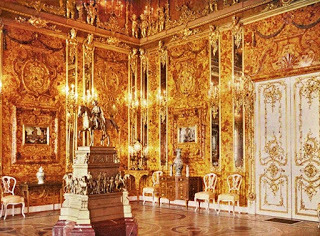
After 60 years of hunting for the missing Amber Room, a magnificent treasure stolen by the Nazis, a museum in Poland suggests that they know where is it located. This is the second time within a year that rumors have run rampant about the treasure being located in Poland.
The Mamerki museum near Węgorzewo, in north east Poland, is one of the most interesting forts related to World War II. The area is still full of secrets (and perhaps a hidden treasure.) According to TVN24, this place has also been connected with the legendary Amber Room, which was created for the Russian tsar Peter the Great in the 1700s.
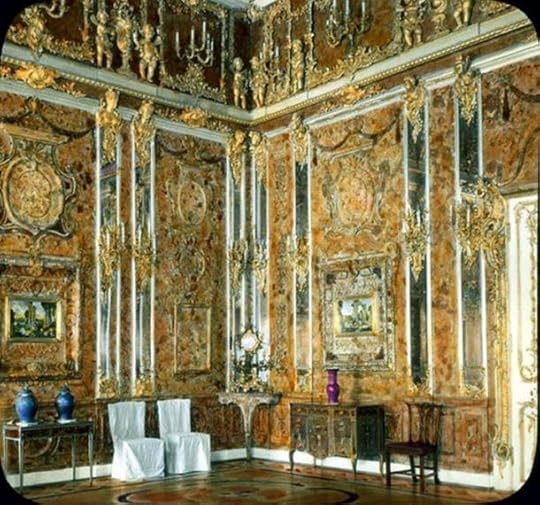 The original Amber Room, 1931. (Public Domain)The museum in Mamerki (in German: Mauerwald) recently reported that they have discovered an unknown room measuring 3 meters (9.84 ft.) long and 2 meters (6.56 ft.) wide. Using geo-radar, they say that they’ve found a secret hidden place located inside an old wartime bunker.
The original Amber Room, 1931. (Public Domain)The museum in Mamerki (in German: Mauerwald) recently reported that they have discovered an unknown room measuring 3 meters (9.84 ft.) long and 2 meters (6.56 ft.) wide. Using geo-radar, they say that they’ve found a secret hidden place located inside an old wartime bunker.
 The geo-radar reading the museum says shows the existence of the hidden bunker. (Mamerki Museum)
The geo-radar reading the museum says shows the existence of the hidden bunker. (Mamerki Museum)
The Amber Room was stolen by the Nazis and was allegedly on its way to becoming one of Adolf Hitler’s greatest treasures when it was lost. The Amber Room originally contained 450kg (992.08lb) of amber decorated with gold, pieces of art, jewels, and mirrors. It was located in St Petersburg from the times of Peter the Great, until the day when the Nazis dismantled it and decided to transport it to Königsberg Castle (Kaliningrad) (which was controlled by them at the time). It was during this transport that it was said to have accidentally disappeared. Strangely enough, the documentation connected with the transport was lost too.The Disappearance of the Amber Room of Charlottenburg PalaceWork Begins to Retrieve Nazi Gold Train Believed to Contain Lost Amber Room of Charlottenburg Palace The suggestion that the Amber Room may be hidden in Mamerki is just one of the hypotheses related to the Amber Room’s location, but the researchers are convinced that it is much more. As Bartlomiej Plebanczyk from the museum told MailOnline:
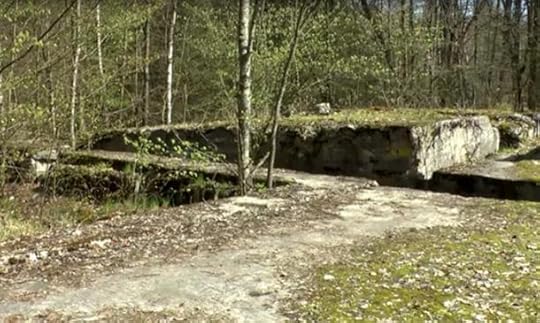 The bunker in Poland where the Amber Room may be located. (TVN24)In 1982, the Russians started to build a replica of the Amber Room. After 20 years, visitors to Catherine Palace, near St Petersburg, can enjoy the beauty of this incredible place once again. Nonetheless, the obsession of treasure hunters in discovering the real Amber Room is still prevalent. During the last 60 years, many of them have lost their lives or suffered from health problems by searching for it.
The bunker in Poland where the Amber Room may be located. (TVN24)In 1982, the Russians started to build a replica of the Amber Room. After 20 years, visitors to Catherine Palace, near St Petersburg, can enjoy the beauty of this incredible place once again. Nonetheless, the obsession of treasure hunters in discovering the real Amber Room is still prevalent. During the last 60 years, many of them have lost their lives or suffered from health problems by searching for it.
In August 2015, Ancient Orgins reported that treasure hunters claimed to have identified a legendary Nazi train packed with gold and other treasure, hidden in a long-forgotten tunnel in the Polish mountains. It was said that the train may also contain the long-lost Amber Room. However, it seems to be unlikely that the train will be explored in the near future. Some of the experts suggested that this location may not even contain a train at all.
Nazi gold train could contain lost Amber Room of Charlottenburg PalaceArchaeologists Launch Official Search for Treasure of King Alaric Sought by the NazisApart from this, there are many other possible hypotheses about the current location of the Amber Room. Some researchers believe that the Amber Room has never left Kaliningrad, and it is buried in the ruins of the city.
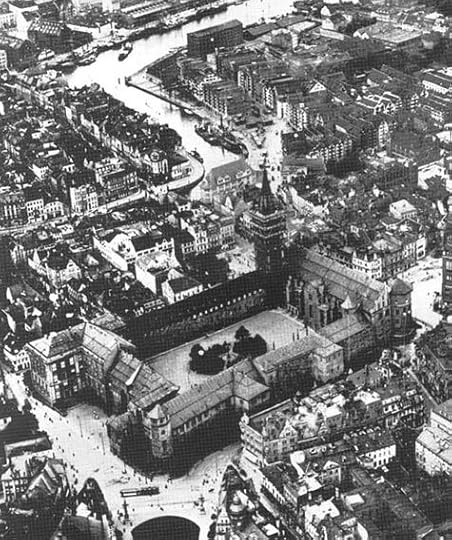 Königsberg Castle, 1925. (Public Domain)Another idea says that it was transported on one of two ships - the Steuben or Wilhelm Gustloff. Both of them sank in the Baltic Sea during World War II. Yet another hypothesis claims that the Amber Room is located in a hidden place somewhere in Russia.
Königsberg Castle, 1925. (Public Domain)Another idea says that it was transported on one of two ships - the Steuben or Wilhelm Gustloff. Both of them sank in the Baltic Sea during World War II. Yet another hypothesis claims that the Amber Room is located in a hidden place somewhere in Russia.
In the 1990s, newspapers in Poland and Russia quoted eyewitnesses who swore that they saw the real Amber Room in a house of one of the noble Russians. This rumor has never been confirmed. Finally, some people also believe that they can find the Amber Room in Germany. For example, an amateur group of treasure hunters hopes to find it in the city of Wuppertal.
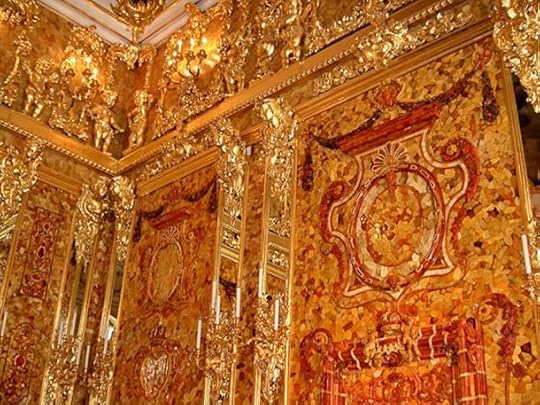 Corner section of the reconstructed Amber Room. (Public Domain)Featured Image: Tsarskoye Selo, Catherine Palace. The Amber Room as it would have appeared in 1917. Source: Public Domain
Corner section of the reconstructed Amber Room. (Public Domain)Featured Image: Tsarskoye Selo, Catherine Palace. The Amber Room as it would have appeared in 1917. Source: Public Domain
By Natalia Klimczak

After 60 years of hunting for the missing Amber Room, a magnificent treasure stolen by the Nazis, a museum in Poland suggests that they know where is it located. This is the second time within a year that rumors have run rampant about the treasure being located in Poland.
The Mamerki museum near Węgorzewo, in north east Poland, is one of the most interesting forts related to World War II. The area is still full of secrets (and perhaps a hidden treasure.) According to TVN24, this place has also been connected with the legendary Amber Room, which was created for the Russian tsar Peter the Great in the 1700s.
 The original Amber Room, 1931. (Public Domain)The museum in Mamerki (in German: Mauerwald) recently reported that they have discovered an unknown room measuring 3 meters (9.84 ft.) long and 2 meters (6.56 ft.) wide. Using geo-radar, they say that they’ve found a secret hidden place located inside an old wartime bunker.
The original Amber Room, 1931. (Public Domain)The museum in Mamerki (in German: Mauerwald) recently reported that they have discovered an unknown room measuring 3 meters (9.84 ft.) long and 2 meters (6.56 ft.) wide. Using geo-radar, they say that they’ve found a secret hidden place located inside an old wartime bunker. The geo-radar reading the museum says shows the existence of the hidden bunker. (Mamerki Museum)
The geo-radar reading the museum says shows the existence of the hidden bunker. (Mamerki Museum)The Amber Room was stolen by the Nazis and was allegedly on its way to becoming one of Adolf Hitler’s greatest treasures when it was lost. The Amber Room originally contained 450kg (992.08lb) of amber decorated with gold, pieces of art, jewels, and mirrors. It was located in St Petersburg from the times of Peter the Great, until the day when the Nazis dismantled it and decided to transport it to Königsberg Castle (Kaliningrad) (which was controlled by them at the time). It was during this transport that it was said to have accidentally disappeared. Strangely enough, the documentation connected with the transport was lost too.The Disappearance of the Amber Room of Charlottenburg PalaceWork Begins to Retrieve Nazi Gold Train Believed to Contain Lost Amber Room of Charlottenburg Palace The suggestion that the Amber Room may be hidden in Mamerki is just one of the hypotheses related to the Amber Room’s location, but the researchers are convinced that it is much more. As Bartlomiej Plebanczyk from the museum told MailOnline:
''We think there is a very good chance that the Amber Room is here for a number of reasons. Of course there were no such devices as ground-penetrating radar in the 1950s, so examining and finding hidden spaces wasn't possible. Inside may be elements of the Amber Chamber, but also other looted art. But there is no doubt that the room was created specifically for the purpose of treasure.''Evidence for the hypothesis comes from a former Nazi guard who told Polish soldiers in the 1950s, that during the winter of 1944 he saw trucks driving up to the bunker. The trucks were said to have been heavily-guarded and they left their large cargo in Mamerki. At the time, the Polish bomb squads looked for proof, but they didn't find anything. The mysterious room where the treasure is thought to be, will be opened during the next few weeks.
 The bunker in Poland where the Amber Room may be located. (TVN24)In 1982, the Russians started to build a replica of the Amber Room. After 20 years, visitors to Catherine Palace, near St Petersburg, can enjoy the beauty of this incredible place once again. Nonetheless, the obsession of treasure hunters in discovering the real Amber Room is still prevalent. During the last 60 years, many of them have lost their lives or suffered from health problems by searching for it.
The bunker in Poland where the Amber Room may be located. (TVN24)In 1982, the Russians started to build a replica of the Amber Room. After 20 years, visitors to Catherine Palace, near St Petersburg, can enjoy the beauty of this incredible place once again. Nonetheless, the obsession of treasure hunters in discovering the real Amber Room is still prevalent. During the last 60 years, many of them have lost their lives or suffered from health problems by searching for it.In August 2015, Ancient Orgins reported that treasure hunters claimed to have identified a legendary Nazi train packed with gold and other treasure, hidden in a long-forgotten tunnel in the Polish mountains. It was said that the train may also contain the long-lost Amber Room. However, it seems to be unlikely that the train will be explored in the near future. Some of the experts suggested that this location may not even contain a train at all.
Nazi gold train could contain lost Amber Room of Charlottenburg PalaceArchaeologists Launch Official Search for Treasure of King Alaric Sought by the NazisApart from this, there are many other possible hypotheses about the current location of the Amber Room. Some researchers believe that the Amber Room has never left Kaliningrad, and it is buried in the ruins of the city.
 Königsberg Castle, 1925. (Public Domain)Another idea says that it was transported on one of two ships - the Steuben or Wilhelm Gustloff. Both of them sank in the Baltic Sea during World War II. Yet another hypothesis claims that the Amber Room is located in a hidden place somewhere in Russia.
Königsberg Castle, 1925. (Public Domain)Another idea says that it was transported on one of two ships - the Steuben or Wilhelm Gustloff. Both of them sank in the Baltic Sea during World War II. Yet another hypothesis claims that the Amber Room is located in a hidden place somewhere in Russia.In the 1990s, newspapers in Poland and Russia quoted eyewitnesses who swore that they saw the real Amber Room in a house of one of the noble Russians. This rumor has never been confirmed. Finally, some people also believe that they can find the Amber Room in Germany. For example, an amateur group of treasure hunters hopes to find it in the city of Wuppertal.
 Corner section of the reconstructed Amber Room. (Public Domain)Featured Image: Tsarskoye Selo, Catherine Palace. The Amber Room as it would have appeared in 1917. Source: Public Domain
Corner section of the reconstructed Amber Room. (Public Domain)Featured Image: Tsarskoye Selo, Catherine Palace. The Amber Room as it would have appeared in 1917. Source: Public DomainBy Natalia Klimczak
Published on May 02, 2016 03:00
History Trivia - Anne Boleyn arrested
May 2
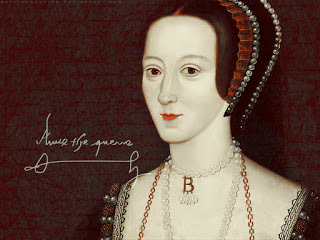
1536 Anne Boleyn, Queen of England, was arrested and imprisoned on charges of adultery, incest, treason and witchcraft.

1536 Anne Boleyn, Queen of England, was arrested and imprisoned on charges of adultery, incest, treason and witchcraft.
Published on May 02, 2016 02:00
May 1, 2016
History Explorer: Life in the Bronze Age
History Extra
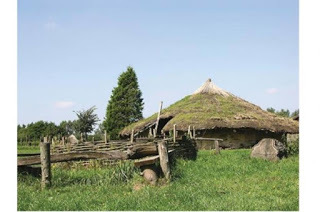
The reconstructed Bronze Age roundhouse at Flag Fen, complete with its insulating turfed and thatched roof. © Rafal Marcinkiewicz
The drive from Peterborough Station to Flag Fen involves a journey across former marshland, drained centuries ago and now covered with industrial buildings. But beneath the modern factories lie the remains of prehistoric settlements, says archaeologist Francis Pryor as he throws his battered Land Rover into gear.
Formerly an expert on Channel 4’s Time Team – now a sheep farmer and author – Pryor has excavated much of Peterborough in his 40-year career. He is perhaps best known for his discovery of Flag Fen – a 3,500-year-old site comprising more than 60,000 vertical posts and 250,000 horizontal timbers that once formed a near 1km-long wooden causeway across the fens.
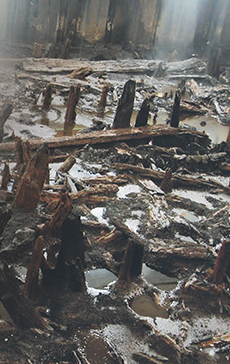
The incredibly well-preserved timbers at Flag Fen are around 3,500 years old. © Mark Pindar
The site is the only place in the world where original Bronze Age timbers can be seen in their original location. And entering the darkened Preservation Hall you get a sense of just how truly remarkable the discovery is. Water drips constantly onto the Bronze Age posts and timbers that date to c1200-1100 BC – it is the waterlogged peat that has preserved the site for so long. The seemingly haphazard arrangement of the wood below the viewing platform hides a much more organised history.
“It’s difficult to imagine now, but the wood we see here once formed part of a huge walkway with a central platform,” says Pryor. “The sand and gravel still visible on the surface isn’t there by chance – it was put there deliberately, probably to stop the wood becoming slippery in wet weather. This was clearly somewhere people visited regularly and, judging from the wealth of artefacts discovered during excavations, it had real spiritual significance. I believe it would have been the Bronze Age equivalent of a parish church, or even a cathedral, where people came to make offerings to the water.”
Changing beliefsThe period around 1500 BC (the middle-late Bronze Age) saw a new set of religious beliefs come into play, says Pryor, with huge centralised structures like Stonehenge abandoned in favour of localised religious sites like Flag Fen. Here, men, women and children would mark rites of passage – births, marriages, the completion of apprenticeships – with symbolic offerings.
“Flag Fen wasn’t a burial site, but it would have marked the passage to the next world,” says Pryor. “Mirrors didn’t exist until c500 BC so the only way people knew what they looked like was by looking at their reflection in still water. It must have been very powerful: water was a symbol of the self but also, beneath the surface, a symbol of death.
“One thing we do know about Bronze Age people is that they held their ceremonies at liminal zones, those at the boundaries. Flag Fen is liminal – you couldn’t have lived out here. It’s a watery wilderness in many respects.”
Some of the artefacts discovered during excavation of the site are displayed in glass cases located outside the Preservation Hall. These give a fascinating, and often surprising, insight into the apparent sophistication of Bronze Age life.
A set of worker’s tools (looking remarkably like a modern socket set), a quern stone for grinding corn and even a flesh hook (used for pulling joints of meat out of cauldrons) are all on show. Analysis of one piece of domestic pottery, a small bowl, apparently revealed evidence of a milky porridge. What is also apparent, from the pieces on display, is that almost all the items were intentionally broken or damaged before being cast into the water.
“And there is even evidence of Bronze Age trade, although not in the sense that we would understand it today,” says Pryor. “We found items made of tin mined in central Europe: tin that was probably exchanged among the more powerful members of Bronze Age society for other items – perhaps on the marriage of a family member, for example. Coins don’t turn up for another 1,000 years or so, but this was still trade of sorts.”
Outside the chamber building, a small flock of sheep wanders the site. These are Soay sheep, a hardy breed that would have been bred in the Bronze Age, as bones uncovered at Flag Fen have revealed.

Flag Fen is home to a small flock of Soay sheep, a breed thought to have descended from those that once grazed in Bronze Age Britain. © Mark Pindar
The dyke where Pryor first discovered the site, in 1982 – quite literally stumbling upon it when he tripped over a piece of what he quickly recognised as Bronze Age timber – is still visible. And on the other side of the narrow bridge spanning the dyke is a reconstructed Bronze Age house. The roof of the circular dwelling is both thatched and turfed, as was the tradition 3,500 years ago – the turf insulating the house against the cold. Inside, the building is dark, with no windows, but the space is larger than might be expected.
“Thanks to excavations of Bronze Age settlements, we know now that the organisation of these houses followed the rotation of the sun,” says Pryor. “Doorways faced south, with food prepared around a central hearth. The most important member of the household would have sat opposite the doorway, on the north side of the house – in the Bronze Age, this would probably have been the grandmother.
“People would have slept on the north and east sides of the house. Interestingly, when we have found Iron or Bronze Age burials, the bodies are always found on the north or east of the burial chamber – the side of sleep and darkness.”
The remains of a Bronze Age eel trap is displayed outside the Preservation Hall – hams, sturgeon, and eels would have hung from the roof, smoking above the fire. The Bronze Age diet, it seems, was a healthy one, and tasty to boot, according to Pryor.
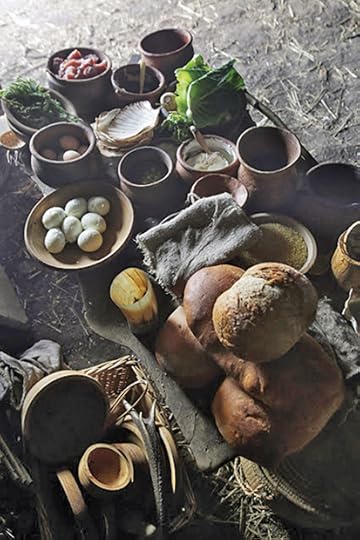
The Bronze Age diet was both healthy and tasty, according to Francis Pryor. © Mark Pindar
Farming the landThe reconstructed roundhouse – based on one excavated in Peterborough by Pryor in the 1970s – gives a real sense of life 3,500 years ago, but the nearest settlement to Flag Fen was in fact about 800m west of the site.
Houses weren’t built near one another until the Iron Age, says Pryor, and in the Bronze Age, houses tended to be carefully spread out among the fields. “By 1500 BC,” he continues, “we’re seeing a landscape that was fully developed, with a network of roads covering Britain and rivers that were being navigated. In 2013, at Must Farm, two miles east of Flag Fen, a length of the river Nene was excavated. In just a 250m section, eight Bronze Age boats were found, presumably abandoned. Rivers must have been the Bronze Age equivalent of motorways: they would have been packed with people.
“The traditional idea of this period of history being one of subsistence agriculture – a family with a few dozen sheep and a couple of moth-eaten old cattle – is old hat. Farming was already intensive. We’ve found whole field systems, as well as yards where sheep would have been handled. As a sheep farmer I know that such areas were intended to handle hundreds, not handfuls, of sheep. These weren’t people scratching a living; they were prosperous, civilised people.”
But the Bronze Age was about more than farming and surviving, according to Pryor. People led remarkably rich lives with plenty of time for leisure and spiritual activity. They even, it seems, enjoyed a tipple.
“I believe people began drinking alcohol as early as 2500 BC,” says Pryor. “After all, fermentation is a pretty basic process – it happens all the time. If you’re a farmer growing wheat and barley and your storage pit gets wet, pretty soon you’re going to get a beer of sorts.
“What’s more, in around 2500 BC we start to see evidence of an extraordinary type of pottery, all over Europe – highly decorated mugs known as beakers. The average beaker holds around two pints and its decoration may well have signified one’s family. These are not the sort of drinking vessels you’d use for a mug of river water!”
Other decorative items have been found during excavations at Flag Fen, including fragments of a bronze shield. But one of the most remarkable finds is a set of shears in a wooden box, dating to c600 BC – to shear sheep, one might assume, but Pryor has another theory.
“Bronze Age sheep like the ones we have here at Flag Fen wouldn’t have needed shearing – they shed their wool naturally. Which means the shears we found were probably used for trimming beards and clipping hair – for looking nice. Caring about one’s personal appearance is not something many people would attribute to Bronze Age society, but I would argue that it formed part of everyday life.”
An excited group of primary school children clad in ‘Bronze Age’ woollen capes borrowed from the visitor centre reminds us that Bronze Age history is now part of the National Curriculum – something Pryor campaigned passionately for. But the future of Flag Fen is far less certain: the site is under constant threat of drying out. Less than 10 per cent of the site has been dug, with an artificial lake created over the largest portion of the ceremonial platform, preserving the Bronze Age timbers, and the site’s history, for future generations.
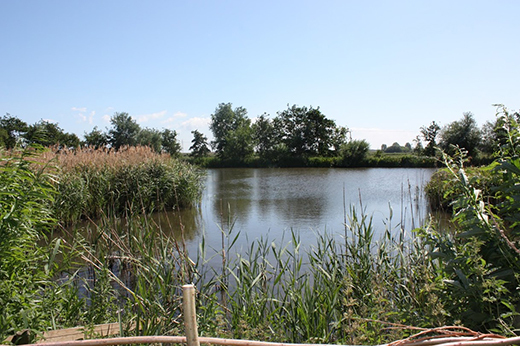
An artificial lake covers, and protects, the remains of Flag Fen’s ceremonial platform. © Rafal Marcinkiewicz
“It’s time to re-educate people about what life in the Bronze Age was really like,” says Pryor, “and dispel the age-old image of wool-clad people huddling around fires in mud and rain, like cavemen. It was a period of great domestic and spiritual change. Civilised life in Britain did not begin with the Roman occupation of AD 43”.
VisitFlag Fen, The Droveway, Northey Road, Peterborough PE6 7QJ
vivacity-peterborough.com/museums-and-heritage/flag-fen
Five more places to explore1. Dover Museum, Kent
Where a prehistoric boat is displayed
In 1992, a Bronze Age boat was discovered during construction of the A20 between Folkestone and Dover. Thought to be around 3,500 years old, the vessel once carried cargos of supplies, livestock and passengers across the Channel, and is tangible evidence of Bronze Age trading. A 9.5m section of this, the world’s oldest known seafaring boat, is on display.
Visit dovermuseum.co.uk
2. Stonehenge, Wiltshire
Where a megalithic stone circle stands
Built in c2500 BC, Stonehenge was an important site of early pilgrimage until the early Bronze Age, when one of the greatest concentrations of round barrows in Britain was built in the surrounding area. The henge monument at Avebury, a 26-mile walk away, was built and altered between 2850–2200 BC but, like Stonehenge, the reason for its existence is still debated.
Visit english-heritage.org.uk
3. Skara Brae, Orkney
Where ancient houses are preserved
Discovered by chance after a storm in 1850, the remains of the late Neolithic settlement at Skara Brae offer an insight into life between c3200 BC and c2200 BC, when the village was inhabited. Orkney itself boasts some 600 Bronze Age burial mounds, including a complex around the Ring of Brodgar, not far from Skara Brae.
Visit orkney.com
4. Lynn Museum, Norfolk
Where Bronze Age timbers are on show
The remains of the Bronze Age timber circle discovered on Holme beach on the north Norfolk coast in 1998 are on show in Lynn Museum, along with a life-size replica. The wooden structure comprised 55 oak posts. In its centre was a huge upturned tree stump, which may have been used as part of a burial ritual.
Visit museumsnorfolk.org.uk/lynn-museum
5. Great Orme Mines, Gwynedd
Where copper was once mined
Mined for copper ores from nearly 4,000 years ago, some four miles of tunnels have been uncovered at Great Orme. Visitors can explore its huge caverns and prehistoric landscape, as well as view Bronze Age mining tools and artefacts.
Visit greatormemines.info
Historical advisor Francis Pryor is the author of Home: A Time Traveller’s Tales from Britain’s Prehistory (Allen Lane, 2014).
Published on May 01, 2016 03:00
Happy May Day
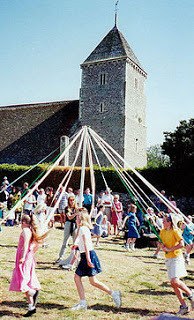
May Day on May 1 is an ancient northern hemisphere spring festival and usually a public holiday; it is also a traditional spring holiday in many cultures. Dances, singing, and cake are usually part of the celebrations that the day includes.
Published on May 01, 2016 03:00
April 30, 2016
What did a lady-in-waiting actually do?
History Extra
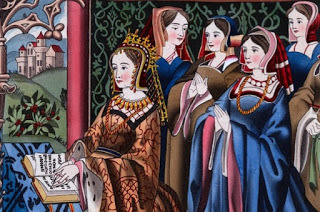
Margaret of Anjou with her ladies-in-waiting, from a tapestry in St Mary's Hall, Coventry. (The Print Collector/Print Collector/Getty Images)
By the 13th century, there was already a firmly-established female presence at the English court – such as Eleanor of Castile’s ‘women and damsels of the Queen’s Chamber’ – and they were expected to perform certain duties.
There were mundane tasks like making their mistress’s bed, carrying messages, accompanying her on visits or being entrusted with her jewels.
At her coronation, Anne Boleyn’s ladies were on hand to “hold a fine cloth before the Queen’s face” when she needed to spit.
But while everyone hoped that the ‘ladies-in-waiting’, as they were known by the 1700s, would set a good, moral example of how one should behave in court, a royal woman would also use her ladies as confidantes or spies.
Answered by one of our Q&A experts, Emily Brand. For more fascinating questions by Emily, and the rest of our panel, pick up a copy of History Revealed! Available in print and for digital devices.

Margaret of Anjou with her ladies-in-waiting, from a tapestry in St Mary's Hall, Coventry. (The Print Collector/Print Collector/Getty Images)
By the 13th century, there was already a firmly-established female presence at the English court – such as Eleanor of Castile’s ‘women and damsels of the Queen’s Chamber’ – and they were expected to perform certain duties.
There were mundane tasks like making their mistress’s bed, carrying messages, accompanying her on visits or being entrusted with her jewels.
At her coronation, Anne Boleyn’s ladies were on hand to “hold a fine cloth before the Queen’s face” when she needed to spit.
But while everyone hoped that the ‘ladies-in-waiting’, as they were known by the 1700s, would set a good, moral example of how one should behave in court, a royal woman would also use her ladies as confidantes or spies.
Answered by one of our Q&A experts, Emily Brand. For more fascinating questions by Emily, and the rest of our panel, pick up a copy of History Revealed! Available in print and for digital devices.
Published on April 30, 2016 03:00
History Trivia - Edmund de la Pole executed
April 30
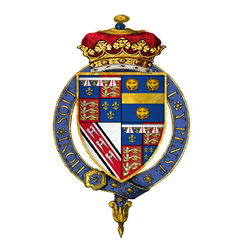
1513 Edmund de la Pole, Yorkist pretender to the English throne, was executed on the orders of Henry VIII.

1513 Edmund de la Pole, Yorkist pretender to the English throne, was executed on the orders of Henry VIII.
Published on April 30, 2016 01:30
April 29, 2016
Unique Scarab Seal from Egyptian Thirteenth Dynasty Discovered in Israel
Ancient Origins
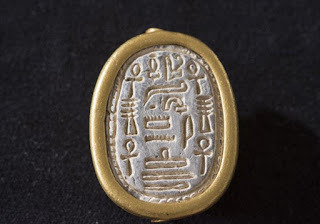
A rare scarab seal has been found in Tel Dor on the Carmel Coast of Israel, south of Haifa. It is dated back to the 18th - 17th centuries BC and belonged to the period of Egypt’s Thirteenth Dynasty.
According to the Jewish Press, Alexander Ternopolsky, a birdwatcher, discovered the artifact. As soon as he made the find, he brought it to the archaeological team working at the site. Professor Ayelet Gilboa from the Department of Archaeology at the University of Haifa, who is heading the excavations at Tel Dor together with Professor Ilan Sharon from the Hebrew University in Jerusalem, believes that the scarab belonged to a high-ranking figure in the Egyptian kingdom, perhaps a viceroy who was responsible for the royal treasury.
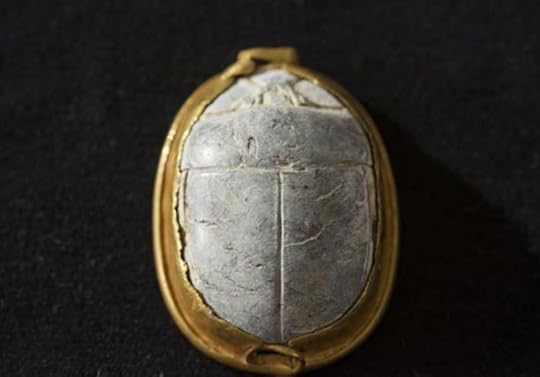 The reverse of the scarab seal found in Tel Dor, Israel. (
Tel Dor Excavations
)Exacavations started at the site in the mid-twentieth century. Since 2002, the work has been led by Professors Gilboa and Sharon. They discovered a settlement related to the Canaanite period (Late Bronze Age, the 2nd millennium BC), a Phoenician settlement, and two centers related to the Iron Age history of the Assyrians and Israelites. They also uncovered remarkable mosaics from the Hellenistic period, and remains from the Roman Period, including the ruins of a temple of Poseidon (aka. Neptune). However, the scarab is the first ancient Egyptian artifact found at the site.
The reverse of the scarab seal found in Tel Dor, Israel. (
Tel Dor Excavations
)Exacavations started at the site in the mid-twentieth century. Since 2002, the work has been led by Professors Gilboa and Sharon. They discovered a settlement related to the Canaanite period (Late Bronze Age, the 2nd millennium BC), a Phoenician settlement, and two centers related to the Iron Age history of the Assyrians and Israelites. They also uncovered remarkable mosaics from the Hellenistic period, and remains from the Roman Period, including the ruins of a temple of Poseidon (aka. Neptune). However, the scarab is the first ancient Egyptian artifact found at the site.
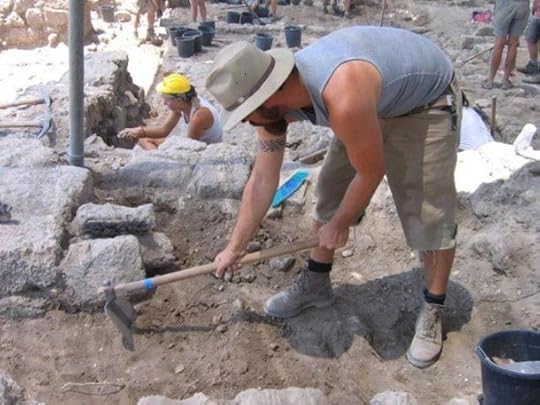 People excavating at Tel Dor, Israel in 2006. (
Public Domain
)Scarabs were very popular objects in ancient Egypt. What makes the one discovered recently in Israel more unique, is its size and quality. The artifact was discovered in an excellent state of preservation. After preliminary studies, the researchers confirmed that the stone scarab contains the engraved name of its owner, but they haven't deciphered it yet. The description of the owner’s position in society includes phrases like ''overseer of the treasury'', ''bearer of the seal'', etc. Apart from those descriptions, archaeologists also recognized the symbol of the ankh, which symbolized eternal life and meant resurrection and stability.
People excavating at Tel Dor, Israel in 2006. (
Public Domain
)Scarabs were very popular objects in ancient Egypt. What makes the one discovered recently in Israel more unique, is its size and quality. The artifact was discovered in an excellent state of preservation. After preliminary studies, the researchers confirmed that the stone scarab contains the engraved name of its owner, but they haven't deciphered it yet. The description of the owner’s position in society includes phrases like ''overseer of the treasury'', ''bearer of the seal'', etc. Apart from those descriptions, archaeologists also recognized the symbol of the ankh, which symbolized eternal life and meant resurrection and stability.
The city of Tel Dor, located near the coast of Isreal and at the foot of Mount Carmel, was a very important port for thousands of years. It is believed that this place may contain the necessary evidence to explain the difficult relationship between the Egyptians and Israelites. The city appears in Egyptian inscriptions dated back to the New Kingdom Period, but the recently discovered scarab from the Middle Kingdom is a very unique discovery.
 Aerial view of the Tel Dor excavation site. (
Sky View / Tel Dor expedition
)The researchers are trying to explain how the scarab of the viceroy reached the city of Tel Dor. One of the possible scenarios is that it arrived there by a representative of the viceroy, who came to the city for trade. Another explanation may be that it was brought there during the Roman period, when ancient artifacts were a precious souvenir. The scarab is currently being displayed at the Mizgaga Museum in Kibbutz Nahsholim. Excavations of the Tel Dor site will resume in July 2016.
Aerial view of the Tel Dor excavation site. (
Sky View / Tel Dor expedition
)The researchers are trying to explain how the scarab of the viceroy reached the city of Tel Dor. One of the possible scenarios is that it arrived there by a representative of the viceroy, who came to the city for trade. Another explanation may be that it was brought there during the Roman period, when ancient artifacts were a precious souvenir. The scarab is currently being displayed at the Mizgaga Museum in Kibbutz Nahsholim. Excavations of the Tel Dor site will resume in July 2016.
Tiny pharaoh-branded amulet may prove fabled military campaign of Sheshonq I Surprise finding as ancient Egyptian sarcophagus is found in IsraelScarabs became popular during the First Intermediate Period (circa 2181 – 2055 BC), and continued to be an important part of religious symbolism until the fall of the ancient Egyptian civilization. They are related to the cult of the god Khepri.
 A Scarab beetle in Tomb KV6, Valley of the Kings, Luxor, Egypt. (
CC BY SA 3.0
)Egyptian artifacts discovered in Israel are a puzzle for researchers, who are still trying to put the pieces in the right order and create an image of the history of these two ancient nations. The famous Egyptologist David Rohl used the enigmatic artifacts to support his theory about the chronology of ancient Egypt.
A Scarab beetle in Tomb KV6, Valley of the Kings, Luxor, Egypt. (
CC BY SA 3.0
)Egyptian artifacts discovered in Israel are a puzzle for researchers, who are still trying to put the pieces in the right order and create an image of the history of these two ancient nations. The famous Egyptologist David Rohl used the enigmatic artifacts to support his theory about the chronology of ancient Egypt.
By analyzing the Bible and other sources, he revised Egyptian chronology and asserted that the previous history of the country near the Nile is untrue. In his book Test of Time, he discussed the rulers from the 19th to the 25th dynasties. It is possible that the current, and future, discoveries in Egypt and Israel will allow researchers to better clarify, and if necessary re-date, other parts of ancient Egyptian history as well.
Featured Image: The ancient scarab seal found in Tel Dor, Israel. Source: Tel Dor Excavations
By Natalia Klimczak

A rare scarab seal has been found in Tel Dor on the Carmel Coast of Israel, south of Haifa. It is dated back to the 18th - 17th centuries BC and belonged to the period of Egypt’s Thirteenth Dynasty.
According to the Jewish Press, Alexander Ternopolsky, a birdwatcher, discovered the artifact. As soon as he made the find, he brought it to the archaeological team working at the site. Professor Ayelet Gilboa from the Department of Archaeology at the University of Haifa, who is heading the excavations at Tel Dor together with Professor Ilan Sharon from the Hebrew University in Jerusalem, believes that the scarab belonged to a high-ranking figure in the Egyptian kingdom, perhaps a viceroy who was responsible for the royal treasury.
 The reverse of the scarab seal found in Tel Dor, Israel. (
Tel Dor Excavations
)Exacavations started at the site in the mid-twentieth century. Since 2002, the work has been led by Professors Gilboa and Sharon. They discovered a settlement related to the Canaanite period (Late Bronze Age, the 2nd millennium BC), a Phoenician settlement, and two centers related to the Iron Age history of the Assyrians and Israelites. They also uncovered remarkable mosaics from the Hellenistic period, and remains from the Roman Period, including the ruins of a temple of Poseidon (aka. Neptune). However, the scarab is the first ancient Egyptian artifact found at the site.
The reverse of the scarab seal found in Tel Dor, Israel. (
Tel Dor Excavations
)Exacavations started at the site in the mid-twentieth century. Since 2002, the work has been led by Professors Gilboa and Sharon. They discovered a settlement related to the Canaanite period (Late Bronze Age, the 2nd millennium BC), a Phoenician settlement, and two centers related to the Iron Age history of the Assyrians and Israelites. They also uncovered remarkable mosaics from the Hellenistic period, and remains from the Roman Period, including the ruins of a temple of Poseidon (aka. Neptune). However, the scarab is the first ancient Egyptian artifact found at the site.“We have not yet reached the settlement of the 17th century BC, and this is why this finding is particularly important. The rains this past winter must have eroded the soil on the southern slope of the site, and thanks to Mr. Ternopolsky’s keen eyesight, the scarab was discovered and handed over to us.” Professor Gilboa explained to the Jewish Press.Enigma of the Heartless Pharaoh: Who Stole the Heart of King Tut, and Why?4,000-Year-Old Necropolis with more than 100 Tombs Discovered Near Bethlehem
 People excavating at Tel Dor, Israel in 2006. (
Public Domain
)Scarabs were very popular objects in ancient Egypt. What makes the one discovered recently in Israel more unique, is its size and quality. The artifact was discovered in an excellent state of preservation. After preliminary studies, the researchers confirmed that the stone scarab contains the engraved name of its owner, but they haven't deciphered it yet. The description of the owner’s position in society includes phrases like ''overseer of the treasury'', ''bearer of the seal'', etc. Apart from those descriptions, archaeologists also recognized the symbol of the ankh, which symbolized eternal life and meant resurrection and stability.
People excavating at Tel Dor, Israel in 2006. (
Public Domain
)Scarabs were very popular objects in ancient Egypt. What makes the one discovered recently in Israel more unique, is its size and quality. The artifact was discovered in an excellent state of preservation. After preliminary studies, the researchers confirmed that the stone scarab contains the engraved name of its owner, but they haven't deciphered it yet. The description of the owner’s position in society includes phrases like ''overseer of the treasury'', ''bearer of the seal'', etc. Apart from those descriptions, archaeologists also recognized the symbol of the ankh, which symbolized eternal life and meant resurrection and stability.The city of Tel Dor, located near the coast of Isreal and at the foot of Mount Carmel, was a very important port for thousands of years. It is believed that this place may contain the necessary evidence to explain the difficult relationship between the Egyptians and Israelites. The city appears in Egyptian inscriptions dated back to the New Kingdom Period, but the recently discovered scarab from the Middle Kingdom is a very unique discovery.
 Aerial view of the Tel Dor excavation site. (
Sky View / Tel Dor expedition
)The researchers are trying to explain how the scarab of the viceroy reached the city of Tel Dor. One of the possible scenarios is that it arrived there by a representative of the viceroy, who came to the city for trade. Another explanation may be that it was brought there during the Roman period, when ancient artifacts were a precious souvenir. The scarab is currently being displayed at the Mizgaga Museum in Kibbutz Nahsholim. Excavations of the Tel Dor site will resume in July 2016.
Aerial view of the Tel Dor excavation site. (
Sky View / Tel Dor expedition
)The researchers are trying to explain how the scarab of the viceroy reached the city of Tel Dor. One of the possible scenarios is that it arrived there by a representative of the viceroy, who came to the city for trade. Another explanation may be that it was brought there during the Roman period, when ancient artifacts were a precious souvenir. The scarab is currently being displayed at the Mizgaga Museum in Kibbutz Nahsholim. Excavations of the Tel Dor site will resume in July 2016.Tiny pharaoh-branded amulet may prove fabled military campaign of Sheshonq I Surprise finding as ancient Egyptian sarcophagus is found in IsraelScarabs became popular during the First Intermediate Period (circa 2181 – 2055 BC), and continued to be an important part of religious symbolism until the fall of the ancient Egyptian civilization. They are related to the cult of the god Khepri.
 A Scarab beetle in Tomb KV6, Valley of the Kings, Luxor, Egypt. (
CC BY SA 3.0
)Egyptian artifacts discovered in Israel are a puzzle for researchers, who are still trying to put the pieces in the right order and create an image of the history of these two ancient nations. The famous Egyptologist David Rohl used the enigmatic artifacts to support his theory about the chronology of ancient Egypt.
A Scarab beetle in Tomb KV6, Valley of the Kings, Luxor, Egypt. (
CC BY SA 3.0
)Egyptian artifacts discovered in Israel are a puzzle for researchers, who are still trying to put the pieces in the right order and create an image of the history of these two ancient nations. The famous Egyptologist David Rohl used the enigmatic artifacts to support his theory about the chronology of ancient Egypt.By analyzing the Bible and other sources, he revised Egyptian chronology and asserted that the previous history of the country near the Nile is untrue. In his book Test of Time, he discussed the rulers from the 19th to the 25th dynasties. It is possible that the current, and future, discoveries in Egypt and Israel will allow researchers to better clarify, and if necessary re-date, other parts of ancient Egyptian history as well.
Featured Image: The ancient scarab seal found in Tel Dor, Israel. Source: Tel Dor Excavations
By Natalia Klimczak
Published on April 29, 2016 03:00
History Trivia - birth of Catherine of Siena
April 29

1347 Catherine of Siena was born. Catherine, the patron saint of Italy, played a significant role in returning the Papacy from Avignon to Rome. She was declared a Doctor of the Church in 1970

1347 Catherine of Siena was born. Catherine, the patron saint of Italy, played a significant role in returning the Papacy from Avignon to Rome. She was declared a Doctor of the Church in 1970
Published on April 29, 2016 01:30
April 28, 2016
12 surprising facts about Queen Elizabeth II
History Extra
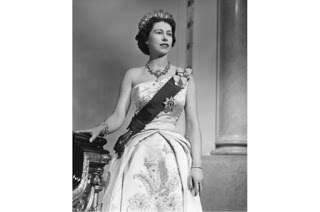 Elizabeth II poses for a portrait in Buckingham Palace in December 1958. (Donald McKague/Michael Ochs Archives/Getty Images)
Elizabeth II poses for a portrait in Buckingham Palace in December 1958. (Donald McKague/Michael Ochs Archives/Getty Images)
On Wednesday 9 September, at around 5.30pm, the Queen will surpass the record held by her great-great grandmother, Queen Victoria, of ruling for 23,226 days, 16 hours and 23 minutes.
Elizabeth acceded to the throne on 6 February 1952.
Reports suggest the royal family will mark the occasion at the Queen’s Scottish home, Balmoral.
Here, we bring you 12 surprising facts about Elizabeth II…
An unlikely queenElizabeth was not expected to become queen. The first child of the Duke and Duchess of York (who later became King George VI and Queen Elizabeth), Elizabeth stood third in line to the throne after her uncle, Edward, Prince of Wales (later King Edward VIII), and her father, the Duke of York.
However, when Elizabeth’s uncle, Edward VIII, abdicated in 1936 in order to marry divorcee Wallis Simpson, Elizabeth’s father acceded to the throne and Elizabeth became first in line.
A young CinderellaThe teenage Princess Elizabeth performed alongside her younger sister, Margaret, in a number of pantomimes during the Second World War.
Never-before-seen images emerged recently of a 15-year-old Elizabeth playing the part of Prince Florizel in Cinderella in 1941.
[image error]
Princess Elizabeth (Queen Elizabeth II) dressed as Prince Charming with Princess Margaret (1930-2002) as Cinderella during a royal pantomime at Windsor Castle, Berkshire, 21 December 1941. (Photo by Lisa Sheridan/Studio Lisa/Getty Images)
Wedding rationsEngaged to Philip Mountbatten (who was then created His Royal Highness The Prince Philip, Duke of Edinburgh) in 1946 (although the formal engagement was delayed until Elizabeth turned 21 in April 1947), the then-princess Elizabeth used ration coupons to buy the material for her wedding dress. The pair wed in November 1947.
According to the Independent, because of rationing the couple’s wedding cake was made using “ingredients given as a wedding present by the Australian Girl Guides”. The cake was baked by McVitie & Price.
ELIZABETH II: THE QUEEN WHO SAVED THE ROYALS
A working motherThe Queen and her husband have four children: Prince Charles and Princess Anne, who were born before Elizabeth became queen, and Prince Andrew and Prince Edward.
When Elizabeth gave birth to Prince Andrew in 1960, she became the first reigning sovereign to have a child since 1857 when Queen Victoria celebrated the arrival of Princess Beatrice.
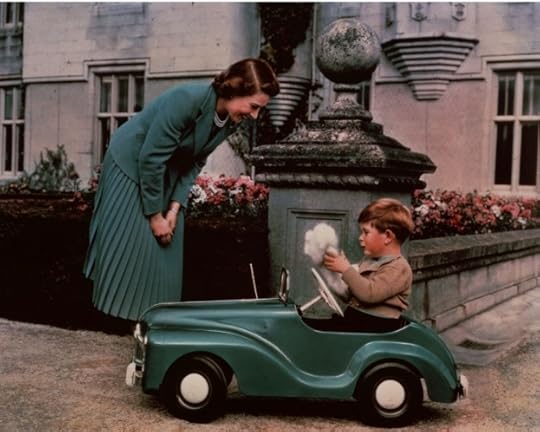
Princess Elizabeth watching Prince Charles playing in his toy car while at Balmoral, 28 September 1952. (Photo by Lisa Sheridan/Studio Lisa/Getty Images)
“Annus horribilis”The year 1992 spelled disaster for the Queen: a fire broke out in Windsor Castle, and the respective marriages of three of her children – Prince Charles, Prince Andrew and Princess Anne – broke down. The Queen deemed this her “annus horribilis” (horrible year).
Staying in touchThe Queen has answered more than three-and-a-half million items of correspondence during her reign so far, and has sent more than 175,000 telegrams to centenarians in the UK and the Commonwealth. She has also sent more than 540,000 telegrams to couples in the UK and the Commonwealth celebrating their diamond wedding anniversary.
The Queen has penned more than 45,000 Christmas cards during her reign, and has given out upwards of 90,000 Christmas puddings to staff.
IN PICTURES: QUEEN ELIZABETH II THROUGH THE DECADES
Strange giftsThe Queen has, during her reign, received a number of unusual gifts – some of them live animals. According to The British Monarchy website, these include two tortoises given to her during a tour of the Seychelles in 1972; a seven-year-old bull elephant called Jumbo, presented by the president of Cameroon in 1972 to mark the Queen's Silver wedding anniversary; and two black beavers during a royal visit to Canada. The animals were placed in the care of London Zoo.
Other curious gifts received by the Queen include a pair of cowboy boots (during a visit to the US); sunglasses, pineapples and 7kg of prawns.
Pooch palsThe Queen has owned more than 30 corgis during her reign. The first, Susan, was given to her as an 18th-birthday present in 1944. It has been reported that Susan accompanied the Queen on her honeymoon – to Broadlands, Hampshire, and Birkhall on the Balmoral Estate – in 1947. Many of the corgis since owned by the Queen were direct descendants from Susan.
Elizabeth’s love of dogs is similar to that of her great-great grandmother, Queen Victoria, who owned a number of German dachshunds and later in life Scottish collies, which she gave the name of Noble.

Queen Elizabeth II at Balmoral Castle with one of her corgis, 28 September 1952. (Photo by Lisa Sheridan/Studio Lisa/Getty Images)
Ships ahoyElizabeth has launched 23 ships during her lifetime, the first being HMS Vanguard on 30 November 1944, in Clydebank, Scotland, when she was Princess Elizabeth.
The first ship Elizabeth launched as queen, on 16 April 1953, was the Britannia, which was also from Clydebank. Other ships launched by the Queen include Elizabeth 2 in 1967, and Queen Mary 2 in 2004.
Royal assentFor a bill to become an act of law, it must first be passed by both the houses of Lords and Commons, and then receive royal assent from the Queen.
Since 1952, the Queen has given royal assent to more than 3,500 acts of parliament.
Prime ministerialThe queen has, over the course of her reign, held regular evening meetings with 12 British prime ministers: Winston Churchill (1951–55); Sir Anthony Eden (1955–57); Harold Macmillan (1957–63); Sir Alec Douglas-Home (1963–64) and Harold Wilson (1964–70 and 1974–76).
The Queen also met regularly with Edward Heath (1970–74); James Callaghan (1976–79); Margaret Thatcher (1979–90); John Major (1990–97); Tony Blair (1997–2007) and Gordon Brown (2007–10). The tradition continues with the current prime minister, David Cameron (2010–present) - the pair usually meet on a Wednesday evening.
Tony Blair was the first prime minister to have been born during Elizabeth’s reign – in May 1953, just a month before the Queen’s coronation.
Interestingly, there have also been 12 US presidents during the queen’s reign: Harry S Truman (1945–53); Dwight D Eisenhower (1953–61); John F Kennedy (1961–63); Lyndon B Johnson (1963–69); Richard Nixon (1969–74); Gerald Ford (1974–77); Jimmy Carter (1977–81); Ronald Reagan (1981–89); George H W Bush (1989–93); Bill Clinton (1993–2001); George W Bush (2001–09) and Barack Obama (2009–present).
[image error]
President Ronald Reagan roars with laughter at a joke delivered by Queen Elizabeth II during a state dinner in San Francisco, March 1983. The 'deadpan'-style joke remarked on the California weather. (Photo by Diana Walker/The LIFE Images Collection/Getty Images)
Record-holderElizabeth II is the 40th monarch since William the Conqueror obtained the crown of England on Christmas Day 1066. She is also the oldest monarch to have celebrated a Golden Jubilee (in 2002 at the age of 76) – the youngest was James VI and I, at the age of 51. Elizabeth was also the first British monarch to celebrate her diamond wedding anniversary, on 20 November 2007.
Only five other kings and queens in British history have reigned for 50 years or more. They are: Victoria, who reigned for 63 years; George III (59 years); Henry III (56 years); Edward III (50 years) and James VI and I (58 years).
Facts courtesy of The British Monarchy website, Time magazine, Vanity Fair and the Independent
To read a profile of Queen Elizabeth, click here.
 Elizabeth II poses for a portrait in Buckingham Palace in December 1958. (Donald McKague/Michael Ochs Archives/Getty Images)
Elizabeth II poses for a portrait in Buckingham Palace in December 1958. (Donald McKague/Michael Ochs Archives/Getty Images) On Wednesday 9 September, at around 5.30pm, the Queen will surpass the record held by her great-great grandmother, Queen Victoria, of ruling for 23,226 days, 16 hours and 23 minutes.
Elizabeth acceded to the throne on 6 February 1952.
Reports suggest the royal family will mark the occasion at the Queen’s Scottish home, Balmoral.
Here, we bring you 12 surprising facts about Elizabeth II…
An unlikely queenElizabeth was not expected to become queen. The first child of the Duke and Duchess of York (who later became King George VI and Queen Elizabeth), Elizabeth stood third in line to the throne after her uncle, Edward, Prince of Wales (later King Edward VIII), and her father, the Duke of York.
However, when Elizabeth’s uncle, Edward VIII, abdicated in 1936 in order to marry divorcee Wallis Simpson, Elizabeth’s father acceded to the throne and Elizabeth became first in line.
A young CinderellaThe teenage Princess Elizabeth performed alongside her younger sister, Margaret, in a number of pantomimes during the Second World War.
Never-before-seen images emerged recently of a 15-year-old Elizabeth playing the part of Prince Florizel in Cinderella in 1941.
[image error]
Princess Elizabeth (Queen Elizabeth II) dressed as Prince Charming with Princess Margaret (1930-2002) as Cinderella during a royal pantomime at Windsor Castle, Berkshire, 21 December 1941. (Photo by Lisa Sheridan/Studio Lisa/Getty Images)
Wedding rationsEngaged to Philip Mountbatten (who was then created His Royal Highness The Prince Philip, Duke of Edinburgh) in 1946 (although the formal engagement was delayed until Elizabeth turned 21 in April 1947), the then-princess Elizabeth used ration coupons to buy the material for her wedding dress. The pair wed in November 1947.
According to the Independent, because of rationing the couple’s wedding cake was made using “ingredients given as a wedding present by the Australian Girl Guides”. The cake was baked by McVitie & Price.
ELIZABETH II: THE QUEEN WHO SAVED THE ROYALS
A working motherThe Queen and her husband have four children: Prince Charles and Princess Anne, who were born before Elizabeth became queen, and Prince Andrew and Prince Edward.
When Elizabeth gave birth to Prince Andrew in 1960, she became the first reigning sovereign to have a child since 1857 when Queen Victoria celebrated the arrival of Princess Beatrice.

Princess Elizabeth watching Prince Charles playing in his toy car while at Balmoral, 28 September 1952. (Photo by Lisa Sheridan/Studio Lisa/Getty Images)
“Annus horribilis”The year 1992 spelled disaster for the Queen: a fire broke out in Windsor Castle, and the respective marriages of three of her children – Prince Charles, Prince Andrew and Princess Anne – broke down. The Queen deemed this her “annus horribilis” (horrible year).
Staying in touchThe Queen has answered more than three-and-a-half million items of correspondence during her reign so far, and has sent more than 175,000 telegrams to centenarians in the UK and the Commonwealth. She has also sent more than 540,000 telegrams to couples in the UK and the Commonwealth celebrating their diamond wedding anniversary.
The Queen has penned more than 45,000 Christmas cards during her reign, and has given out upwards of 90,000 Christmas puddings to staff.
IN PICTURES: QUEEN ELIZABETH II THROUGH THE DECADES
Strange giftsThe Queen has, during her reign, received a number of unusual gifts – some of them live animals. According to The British Monarchy website, these include two tortoises given to her during a tour of the Seychelles in 1972; a seven-year-old bull elephant called Jumbo, presented by the president of Cameroon in 1972 to mark the Queen's Silver wedding anniversary; and two black beavers during a royal visit to Canada. The animals were placed in the care of London Zoo.
Other curious gifts received by the Queen include a pair of cowboy boots (during a visit to the US); sunglasses, pineapples and 7kg of prawns.
Pooch palsThe Queen has owned more than 30 corgis during her reign. The first, Susan, was given to her as an 18th-birthday present in 1944. It has been reported that Susan accompanied the Queen on her honeymoon – to Broadlands, Hampshire, and Birkhall on the Balmoral Estate – in 1947. Many of the corgis since owned by the Queen were direct descendants from Susan.
Elizabeth’s love of dogs is similar to that of her great-great grandmother, Queen Victoria, who owned a number of German dachshunds and later in life Scottish collies, which she gave the name of Noble.

Queen Elizabeth II at Balmoral Castle with one of her corgis, 28 September 1952. (Photo by Lisa Sheridan/Studio Lisa/Getty Images)
Ships ahoyElizabeth has launched 23 ships during her lifetime, the first being HMS Vanguard on 30 November 1944, in Clydebank, Scotland, when she was Princess Elizabeth.
The first ship Elizabeth launched as queen, on 16 April 1953, was the Britannia, which was also from Clydebank. Other ships launched by the Queen include Elizabeth 2 in 1967, and Queen Mary 2 in 2004.
Royal assentFor a bill to become an act of law, it must first be passed by both the houses of Lords and Commons, and then receive royal assent from the Queen.
Since 1952, the Queen has given royal assent to more than 3,500 acts of parliament.
Prime ministerialThe queen has, over the course of her reign, held regular evening meetings with 12 British prime ministers: Winston Churchill (1951–55); Sir Anthony Eden (1955–57); Harold Macmillan (1957–63); Sir Alec Douglas-Home (1963–64) and Harold Wilson (1964–70 and 1974–76).
The Queen also met regularly with Edward Heath (1970–74); James Callaghan (1976–79); Margaret Thatcher (1979–90); John Major (1990–97); Tony Blair (1997–2007) and Gordon Brown (2007–10). The tradition continues with the current prime minister, David Cameron (2010–present) - the pair usually meet on a Wednesday evening.
Tony Blair was the first prime minister to have been born during Elizabeth’s reign – in May 1953, just a month before the Queen’s coronation.
Interestingly, there have also been 12 US presidents during the queen’s reign: Harry S Truman (1945–53); Dwight D Eisenhower (1953–61); John F Kennedy (1961–63); Lyndon B Johnson (1963–69); Richard Nixon (1969–74); Gerald Ford (1974–77); Jimmy Carter (1977–81); Ronald Reagan (1981–89); George H W Bush (1989–93); Bill Clinton (1993–2001); George W Bush (2001–09) and Barack Obama (2009–present).
[image error]
President Ronald Reagan roars with laughter at a joke delivered by Queen Elizabeth II during a state dinner in San Francisco, March 1983. The 'deadpan'-style joke remarked on the California weather. (Photo by Diana Walker/The LIFE Images Collection/Getty Images)
Record-holderElizabeth II is the 40th monarch since William the Conqueror obtained the crown of England on Christmas Day 1066. She is also the oldest monarch to have celebrated a Golden Jubilee (in 2002 at the age of 76) – the youngest was James VI and I, at the age of 51. Elizabeth was also the first British monarch to celebrate her diamond wedding anniversary, on 20 November 2007.
Only five other kings and queens in British history have reigned for 50 years or more. They are: Victoria, who reigned for 63 years; George III (59 years); Henry III (56 years); Edward III (50 years) and James VI and I (58 years).
Facts courtesy of The British Monarchy website, Time magazine, Vanity Fair and the Independent
To read a profile of Queen Elizabeth, click here.
Published on April 28, 2016 03:00



